The Birth of the Taunus Marque
The year 2019 marked 80 years since the first Ford Taunus was built in Germany. Taunus production started in 1939, lasting a total of 55 years.
The year 2019 marked 80 years since the first Ford Taunus was built in Germany. Taunus production started in 1939, lasting a total of 55 years.
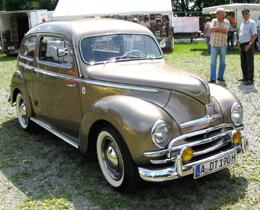
Image © Wikipedia.
The revised model, the G73A, was built from 1948-1952. The G93A and G73A model range included Estates and Van's, both using the 1172cc engine.
From 1952 to 1968 all the of the cars were now branded as Taunus, using the names 12m, 15m, 17m, 20m and 26m to distinguish the various models. The “m” designation is said to stand for "Meisterstuck", which translates into English as Masterpiece.
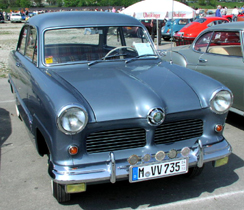
Image © Wikipedia.
A Second Generation P1 was available from 1959-1962. This was a reworked model of the existing P1, with smoother lines and sculpted side panels.
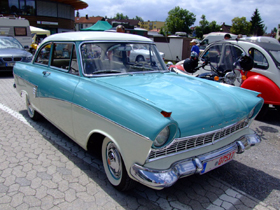
Image © Wikipedia.
The P2, with its 1700cc engine producing 60hp could reach 80mph, through its 3 speed, all syncro gearbox.

Image © Wikipedia.
All 4 corners of the car were curved, unlike its predecessor, with the front-end styling reminiscent of the Ford Thunderbird. With same engine as the P2, the P3 with its more aerodynamic body gained another 6mph on the top speed.
New for the P3 were the rectangular or lozenge-shaped (non-round) headlights. This technical innovation was developed by Hella and was the first application of non-round headlights to a vehicle. The lozenge shape was so radical that US law dictated that headlamps should be round and, therefore, these new headlights were deemed illegal for use in the USA.
The P3 had three engine options: 1.5L, 55hp with a top speed of 85mph. The 1.7L, had 60-65hp and reached 86mph - 88mph and the 1.8L, with 70-75hp topped out at 92mph - 96mph.

Image © Wikipedia.
The V4 was available in 1.2L and 1.5L capacity. The 1.2L produced 40hp with a top speed of 77mph, whilst the 1.5L ranged from 50-65hp and with top speeds of between 84 to 90 mph respectively.
Body styles ranged from a 2-door sedan, 4-door sedan, 2-door coupe, 2-door Station-wagon, and sedan delivery.
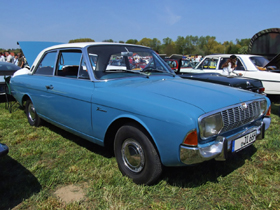
Image © Wikipedia.
The P5 came with a new body shell and floor pan, with revised engines once again. The engine options were the 1.5L, 60hp & 88mph. 1.7L, 65-70hp & 91-94mph.
This was then followed by a 20m version, with V6 configuration. The v6 came in either 1.8L or 2.0L format. The 1.8L had 82hp and was good for 99mph with the 2.0L having between 85-90hp and finally breaking the magic “ton” with a top speed of 101mph. Like the P3, the P5 was well received and a good selling car.

Image © Wikipedia.

Image © Wikipedia.

Image © Wikipedia.
Launched in September of 1967, and discontinued just 11 months later in August 1968, came the P7 models. The P7a and then a facelifted P7b.
The P7a, had a larger footprint than its predecessor, and an Anglo American feel and design. Quite different to anything produced previously.
At this point the Taunus name was dropped, with the feeling that the models and designations were too much of a mouthful. However, the P7's would be the last of the "True Designed" Taunus cars built. After the seventh Taunus variant since World War II, and after a twenty-year run, the Taunus badged cars came to an end.
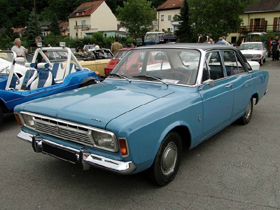
Image © Wikipedia.
During the 11 months of P7a production, just 156,000 were produced with an engine range comprising the 1.5L V4, 1.7L V4, 1.8L V6, 2.0L V6 and the 2.3L V6. The P7a came in a variety of bodystyles, namely 2-door and 4-door saloons, 3-door or 5-door Turnier Estates, and a 2-door Coupe.
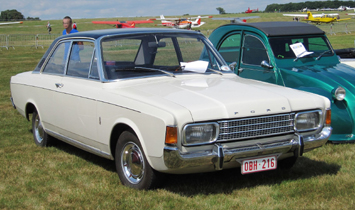
Image © Wikipedia.
In mid-1969, a flagship model of the P7b was announced, the 26m. With its 2.55L V6 engine, automatic gearbox, vinyl topped roof with sun-roof, power steering, twin headlamps, larger front brakes, tinted windows and interior trim upgrades the model caused quite a stir. The 26m was available in only two guises; namely a 4-door saloon and a 2-door coupe.
By now, the writing was on the wall.
In 1970, Ford of Germany and Ford of England had joined forces at many different levels to form Ford of Europe and huge changes were due to take place in the coming years.
So, with the last Taunus P7b produced in December 1971, the name and brand ended in Germany. However, production continued elsewhere around the world, notably in Argentina.
In a very competitive European car market, with Opel, Audi and Volkswagen all gaining larger shares of the customer base, Ford of Germany joined forces with Ford of England to streamline production, while at the same time cutting costs. The first model produced after the last Taunus, was the mk1 Granada.
Sadly, with the unveiling of the mk1 Granada, here ends the story of the "true" European Taunus brand.